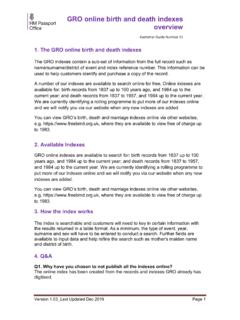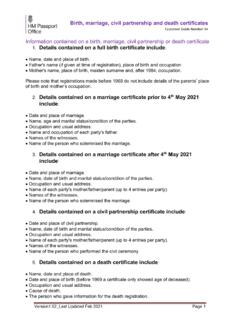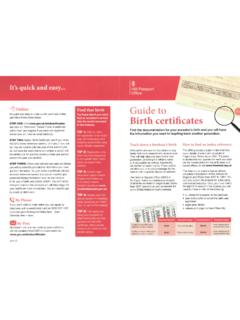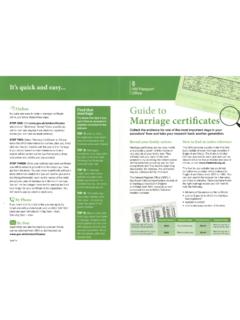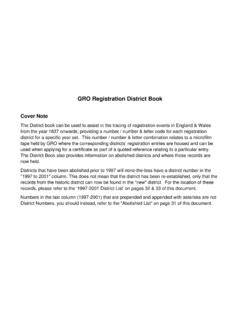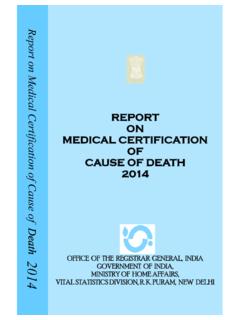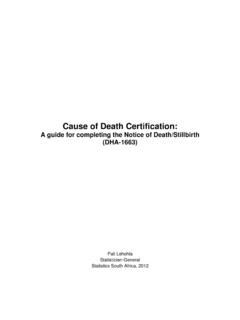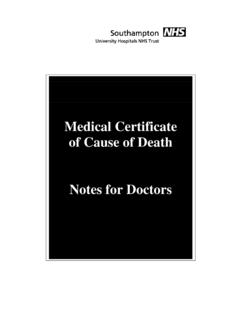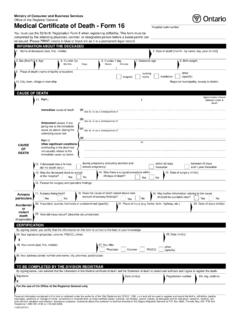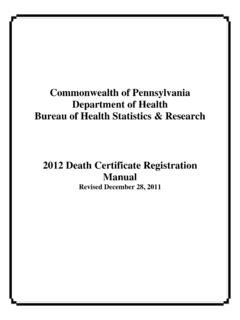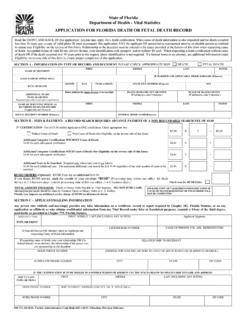Transcription of Guidance for doctors completing Medical Certificates of ...
1 Guidance for doctors completing Medical Certificates of Cause of death in England and Wales From the Office for National Statistics death Certification Advisory Group, Revised July 2010 1 The purposes of death 2 2 Planned changes to death 2 3 Who should certify the death ? .. 3 4 Referring deaths to the 3 5 How to complete the cause of death 4 Sequence leading to death , underlying cause and contributory causes .. 4 Results of investigations 7 Avoid old age 7 Never use natural causes 8 Avoid organ failure alone .. 8 Avoid terminal events, modes of dying and other vague 9 Never use abbreviations or symbols .. 9 6 Specific causes of 9 Stroke and cerebrovascular disorders .. 9 10 Diabetes 11 Deaths involving infections and communicable 12 Injuries and external causes .. 14 Substance misuse .. 14 This Guidance is intended to complement the notes for doctors in the front of every book of MCCDs.
2 Those instructions remain current, except for the change in lower age limit at which old age is thought to be acceptable as the sole cause of death (now 80 instead of 70, as covered in detail below). doctors should familiarise themselves with the MCCD notes, and consult them if they are in any doubt about whether, or how, to certify a death . F66 Guidance 1 2 1 The purposes of death certification death certification serves a number of functions. A Medical certificate of cause of death (MCCD) enables the deceased s family to register the death . This provides a permanent legal record of the fact of death and enables the family to arrange disposal of the body, and to settle the deceased s estate.
3 Information from death Certificates is used to measure the relative contributions of different diseases to mortality. Statistical information on deaths by underlying cause is important for monitoring the health of the population, designing and evaluating public health interventions, recognising priorities for Medical research and health services, planning health services, and assessing the effectiveness of those services. death certificate data are extensively used in research into the health effects of exposure to a wide range of risk factors through the environment, work, Medical and surgical care, and other sources. After registering the death , the family gets a certified copy of the register entry ( death certificate ), which includes an exact copy of the cause of death information that you give. This provides them with an explanation of how and why their relative died. It also gives them a permanent record of information about their family Medical history, which may be important for their own health and that of future generations.
4 For all of these reasons it is extremely important that you provide clear, accurate and complete information about the diseases or conditions that caused your patient s death . 2 Planned changes to death certification The first major changes to death certification in England and Wales since 1953 are set out in the Coroner and Justice Act, which gained Royal Assent in November 2009 ( ). Part 1 (of nine) of the Act deals with the coroner service, investigation of deaths by coroners, death certification by doctors and the creation of a Medical examiner service in England and Wales. This new legislation has not been implemented yet. The Ministry of Justice (MoJ) and Department of Health (DH) are working towards simultaneous implementation of changes to the coroner service and death certification, which will probably begin in 2012. doctors will be informed, and updated Guidance will be made available, before the changes come into force. Reforms of death certification will unify procedures for all deaths, whether the body is to be buried or cremated.
5 PCTs in England and LHBs in Wales will be required to appoint Medical examiners, who will scrutinise the MCCDs, patient records and circumstances of all deaths not investigated by coroners before the deaths are registered. There will be a statutory post in the Department of Health for a National Medical Examiner. DH will consult on policy later in 2010, before drafting regulations for the new service. Updates will be available from the DH website at Details of the changes that will be made to the coroner service are available from the Ministry of Justice include the appointment of a National Chief Coroner and Medical Advisor to the Chief coroner and a new statutory duty on doctors to report deaths that should be investigated to a senior coroner. A MoJ consultation on policy for the regulations is available at The closing date for responses from individuals and organisations is 1 July 2010. 3 This Guidance is to remind you of the continuing duties on Medical practitioners until the new legislation is implemented, and to clarify best practice.
6 3 Who should certify the death ? When a patient dies it is the statutory duty of the doctor who has attended in the last illness to issue the MCCD. There is no clear legal definition of attended , but it is generally accepted to mean a doctor who has cared for the patient during the illness that led to death and so is familiar with the patient s Medical history, investigations and treatment. The certifying doctor should also have access to relevant Medical records and the results of investigations. There is no provision under current legislation to delegate this statutory duty to any non- Medical staff. In hospital, there may be several doctors in a team caring for the patient. It is ultimately the responsibility of the consultant in charge of the patient's care to ensure that the death is properly certified. Any subsequent enquiries, such as for the results of post-mortem or ante-mortem investigations, will be addressed to the consultant. In general practice, more than one GP may have been involved in the patient s care and so be able to certify the death .
7 If no doctor who cared for the patient can be found, the death must be referred to the coroner to investigate and certify the cause. If the attending doctor has not seen the patient within the 14 days preceding death , and has not seen the body after death either, the registrar is obliged to refer the death to the coroner before it can be registered. In these circumstances, the coroner may instruct the registrar to accept the attending doctor s MCCD for registration, despite the prolonged interval. In contrast, a doctor who has not been directly involved in the patient s care at any time during the illness from which they died cannot certify under current legislation, but he should provide the coroner with any information that may help to determine the cause of death . The coroner may then provide this information to the registrar of deaths. It will be used for mortality statistics, but the death will be legally uncertified if the coroner does not investigate through an autopsy, an inquest, or both.
8 4 Referring deaths to the coroner Registrars of births and deaths are under a legal duty to report certain categories of deaths to the coroner before they can be registered. These include deaths which may be due to accident, suicide, violence, neglect (by self or others) or industrial disease and deaths for which the cause is not known. Deaths occurring during an operation, or before full recovery from an anaesthetic, as well as deaths occurring in, or shortly after release from, police or prison custody, should also be reported. In practice, doctors usually report such deaths themselves and seek the advice of the coroner. The Office for National Statistics (ONS) encourages doctors to do this and to explain to the family why the death is being referred, as well as how and when they will learn the outcome of the referral. The coroner should also be informed if there is no doctor who attended the deceased available to certify, or if the certifying doctor did attend the deceased, but has not seen them either within 14 days before death , or after death .
9 Strictly speaking, the law requires that the doctor should complete an MCCD even when a death has been referred to the coroner. In practice, if the coroner has decided to order a post-mortem and/or to hold an inquest, he may tell the doctor not to complete the MCCD. However, the 4 coroner can only legally certify the cause of death if he has investigated it through autopsy, inquest or both. This means that, if the coroner decides not to investigate, the registrar will need to obtain an MCCD from a doctor who attended the deceased before the death can be registered. This may cause inconvenience to you and the family, if you have not already provided one. When a death is referred, it is up to the coroner to decide whether or not it should be investigated further. It is very important that the coroner is given all of the facts relevant to this decision.
10 The doctor should discuss the case with the coroner before issuing an MCCD if at all uncertain whether he or she should certify the death . This allows the coroner to make enquiries and decide whether or not any further investigation is needed, before the family tries to register the death . The coroner may decide that the death can be registered from the doctor's MCCD. For example, 75% of deaths with fractured neck of femur mentioned on the certificate are registered from the original MCCD following referral to the coroner, while only about 15% go to inquest, and 10% are registered after a coroner's autopsy. Omitting to mention on the certificate conditions or events that contributed to the death in order to avoid referral to the coroner is unacceptable. If these come to light when the family registers the death , the registrar will be obliged to refer it to the coroner. If the fact emerges after the death is registered, an inquest may still be held.
